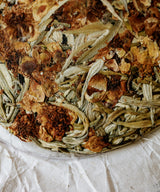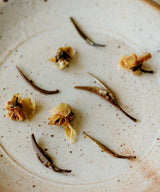Silver Needle & Tea Blossoms
茶花银针
Harvest
December 2023
Origin
Jinggu, Yunnan
Mr. Tang left his corporate job in the city, Kunming, in 2006. He had rented a small place in rural Yunnan where his only intentions were to read, reflect, and drink tea with friends. In one of these conversations an old friend, Li, suggested that Tang grow tea in Li’s hometown, Yangta Village. That July the two of them traveled to Jinggu in Yangta and leased 11 acres of forested area from Li’s niece.
The area they leased was wild growth, at about 6500 ft elevation. This is where they would eventually plant 70,000 Jinggu Big White tea trees. Tang also leased another tea garden in the mountain that locals had shown him; a highly regarded area that was home to ancient pu’erh trees. And so, while he waited for his Jinggu Big Whites, Tang began making pu’erh from these very old trees.
We visited Tang’s tea estate in April 2019 and Tang took us on the steep hike to see his pu-erh tea garden. I spent several hours there, observing the graceful and efficient way that the elders harvested the tea leaves, studying the trunk structures of the ancient trees, and admiring the vibrant mosses that had grown on them.
For Mr. Tang, crafting beautiful teas from a clean and balanced ecosystem is sacred. He is deeply dedicated to the craft of traditional tea making; this philosophy guides everything he does, and is embedded in every single tea he makes. Alongside being an expression of this special ecosystem, his teas are so distinctly peaceful, and feel extremely clear, just as he feels as a person.
Tea Flower in Silver Needle, is a very unique and special tea from our collection of Mr. Tang’s tea. The Silver Needle is made from the leaves of the Jinggu Big White varietal – trees that Mr. Tang had planted when he first started his tiny organic tea farm 18 years ago.
Tea trees flower! – Something easy to forget, as we are always so engaged with their leaves. They blossom once every year, in November. The delicate flowers used to make this tea come from the same trees grown on Mr. Tang’s farm. They are carefully hand harvested as they bloom, and left to slowly dry in the sun, before being finished over charcoal to remove their remaining moisture; a process that takes over two weeks.
We will always be struck by the appearance of this tea cake: the contrast of the burnt-orange flowers pressed into the pale, silver needles. Both the orange of the dried blossom and the liquor it brews is a deeper colour this year. Wet in the gaiwan, the petals and leaves look fleshy and metallic, almost like copper.
On the palate, the sweetness imparted by the flower’s nectar coils around the crisp, refreshing notes of the white tea.The character of the tea is quick to emerge, whereas in previous years we have had to be patient for it to open up. We also find this year’s harvest to be less glycerol and weighty than previous years, allowing us to appreciate the clearing quality that these leaves and flowers can produce in concert.
. . .
Brewing guide
| Tea | 4g |
| Temperature | 90-100 °C |
| Water | 120ml |
| Steep time | 10 - 90 sec |
| No. of infusions | 10+ |


















